Home » Adventures » Backpacking Europe » Germany
I first visited Königsee, a beautiful lake surrounded by mountains but also overflowing with tourists. Instead of taking the chairlift into the mountains I headed up them on foot and enjoyed a steady climb through the trees. From high up I continued along the side of the lake, following the mountain’s undulating contour along track that was sometimes very narrow, and on other occasions gravel road. I could not often see the lake from the mountainside, but still enjoyed my stroll and several spots provided amazing views of the Alps on a clear summer day. The next morning I finished the steep descent to the lake and caught the ferry at Salet for a ride back. It was a great trip across a gorgeous body of water with giant mountains rising steeply from each side.

I also made an assault on Eagle’s Nest (Kehlstein) along with a million other people. I never knew Hitler’s former retreat was this popular, only aware of it from my guidebook and Band of Brothers, but on this picture perfect day the acme was packed. Nothing much historical was left from its Nazi origins, and it now serves as a mountaintop cafe and lookout. Still, after a twisty bus ride up, the final climb was in a golden elevator like Hitler used. The views from the top of Eagle’s Nest really were spectacular on this clear day. I enjoyed looking at all the surrounding mountains and steep peaks.
After flying in from Mongolia I started my summer backpacking Europe in Germany’s capital.

Brandenburg Gate: The Brandenburg Gate was an impressive, imposing structure even without its powerful symbolism from the Cold War. Although the fact that it was originally built over 200 years ago primarily to collect taxes detracted from its mystique.
Holocaust Memorial: Germany is very cognizant about recognizing its Nazi past and does not hide the horrors that were committed during their reign. One striking example of this was the Memorial to the Murdered Jews of Europe (Holocaust Memorial) in Berlin. It was an entire city block of rectangular concrete slabs of varying height. I did not entirely understand the symbolism though, so I was a little confused walking around the blocks. Also, streets surrounded the memorial on three sides, producing a good deal of traffic noise.
I found the museum underneath much more captivating, with its specific accounts of the wide scale horrors that transpired under he Nazis. Besides the gas champers with which I was more familiar, I never realized the scale of the mass shootings that also occurred. At least as many people were murdered in that manner as from poison gas. I also learned that the prisoners who were not immediately killed in the concentration camps were intentionally worked to death. I knew of the deaths and inhuman conditions in the work camps, but never realized they were intended as another way to murder people. More new information that I learned included that Hitler broke his nonaggression pack with Russia as a deliberate attempt to annex land in the east for Germany. He considered the people there inferior and seized the land for the food, materials and labor for the Third Reich.
Topography of Terror: Located at the former SS headquarters, this exhibit explained the rise of the Nazi party and documented some of the atrocities it committed. The violence started before they even came to power as they attacked political opponents, and later systemically expanded to anyone deemed unworthy or an enemy, especially the Jews

Berlin Wall: A few tributes to the wall which divided the city for decades are around the city, including a original stretches of Wall. The suddenness with which the Wall both went up and finally came down was amazing. Both events basically occurred overnight. The Wall though was continually expanded and improved over the course of its lifetime. I never realized how strikingly it divided the city either, running down the middle of streets, along the edges of buildings, and even splitting a subway station. The ironically named Church of Reconciliation was even located in the middle of the Wall’s death strip for twenty years, until eventually demolished by the East German government.
A recreation of the Wall and the death strip was interesting, showing how tall it was and the wide no mans land. From street level you could not see inside either, just as during the Cold War. Only by climbing a nearby observation tower could you peer over the Wall to the wide strip beyond and all the defenses used to prevent people from crossing.
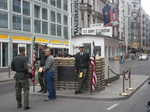
Checkpoint Charlie: The famous Berlin Wall crossing during the Cold War had been recreated for a disappointing tourist trip. A few memorials and museums about the Wall were around, but the area itself was very modern and bustling with tourist shops and cafes everywhere. The only marker at the spot was a restored guard house, which seemed mostly to exist to charge people for photos in front of it.
German Historical Museum: This museum documented the human history in the country. In summary, since the beginning of time until WWII, Europe was basically in a series of unending wars by power hungry kings. The names, places, and dates varied, but the basic plot was the same. Since WWII they have simmered down to just a Cold War and smaller scale wars outside the heart of Europe.
I wandered about München a while, seeing the Rathaus with its Glockenspiel and Marienplatz with its tourist shops, but quickly discovered not much interested me. Even the copious and overpriced beer halls had no pull. The Dachau Concentration camp was situated nearby though, which was fascinating.
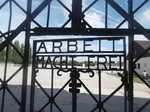
Dachau was the first Nazi concentration camp, used to hold political opponents from the beginnings of the Nazi rise to power. The camp grew and evolved, and eventually became a work camp for enslaved Jews. Although it had a small gas chamber, mass exterminations by poison gas were not carried out here. Instead the prisoners able to work were forced to toil under harsh conditions with meager rations. Most would eventually die from exhaustion, or were shipped off to death camps when they became too weak for labor. The camp did have a crematorium though, to destroy the massive number of bodies that amassed through the “attrition” of workers. Incomprehensible torture from beatings, to shootings, to horrible mental and dehumanizing treatment also occurred on these grounds. Involuntary medical experiments were carried out on some prisoners. The tests, which were about hypothermia and exposure to low pressure, killed most of the people forced to participate.
Most of the barracks that housed the prisoners had been torn down, but their footprints remained, showing the camp’s massive scale. The former administrative buildings had exhibits on the admittance process for new prisoners, as well as documenting atrocities that occurred at this camp. A separate prison block behind those buildings was where defiant or rebellious prisoners were held in isolation and often tortured.
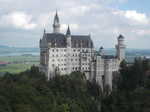
I made a quick trip to Neuschwanstein Castle, just to see the famous tourist spot. Mad King Ludwig built it after castles had become obsolete explicitly to look like his vision of an ideal castle, without any heed to practicalities like defense. Disney World’s Cinderella castle was based off of it, although Neuschwanstein Castle had a higher concentration of tourists per square meter than Disney. I had no desire to go inside the castle, even if the line was short and entrance was free, which of course were not the case. I wandered about the outside admiring the fairy tale view. The surrounding mountains were more beautiful than I expected, and I really this introduction to the Bavarian Alps.
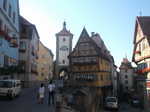
I spent a morning wandering around Rothenburg ob der Tauber. Its only claim to fame is being a medieval walled city with picturesque streets and shops. The town had its charm as I explored its streets, gardens, and walkway atop the wall, but it never captivated me. The buildings all seemed new and colorful, but built to a period look. It felt completely opposite from the medieval city of Edinburgh with its authentic old stone buildings that I really liked. So this tourist magnet defiantly was not my favorite spot in Europe, but I cannot always hit a homerun.
Being Lutheran, I made the pilgrimage to Wittenberg. Unfortunately much of the town was undergoing refurbishment ahead of the 500th anniversary of the reformation, so scaffolding adorned the inside and outside of many buildings. Still, I was able to see City and Castle Church, and the actual doorway where the 95 thesis were hung. With the city having modernized and grown since then, imagining Luther nailing them to the door in that very spot was a little difficult. I got to peek inside Castle Church despite the construction, but as a result of the work Luther’s gravestone was the only thing to see.
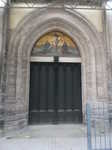
Luther House: The house where Martin Luther lived is now a museum. It had a nice collection of artifacts, including the pulpit from which Luther actually preached. I was pleasantly surprised to discover that in the information panels explaining the Reformation, the Gospel was included. It did not make up some PC social revolution, but correctly stated salvation through grace alone was at the heart of the Reformation. The exhibits walked through the events of Luther’s life and the Reformation, some of which I remembered from Catechesis. A lot of Christian artwork was on display, ranging from the Ten Commandments, to the Passion, to criticizing the Pope.
Philipp Melanchthon House: The author of the Augsburg Confession — a founding document of the Reformation — and a friend of Luther, Philip Melanchthon’s house has also been turned into a museum. The history on the house itself was not that interesting, but the section on its inhabitant was. He was a bright scholar in many areas and had a vast collection of books and letters. The exhibit emphasized his academic side, and did not highlight much of his religious work. Although I am not sure on that balance truly was in his life. Electronic interactive copies of the Augsburg Confessions were at least on hand, which were nice to browse through.
I had the opportunity at attend an English language devotions inside a small chapel next to City Church. Participating in this mini Service “A Might Fortress is our God” in Wittenberg was a blessing.